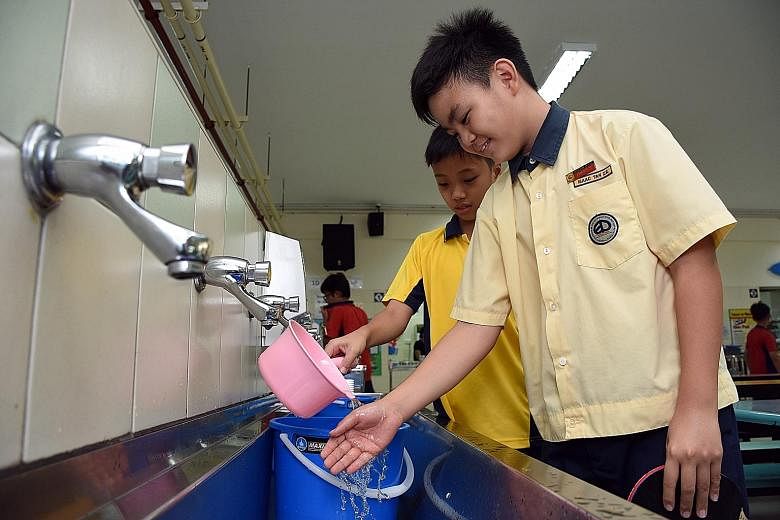Water rationing is not yet on the cards for Singapore, but people should save water in their own ways, said Minister for the Environment and Water Resources Masagos Zulkifli yesterday.
"We have not had water rationing since 1964, and I don't think that, with all the preparation we have in place with Newater and desalination, we would have to do so.
"However, it does not mean that we should take our water supply for granted," he told reporters during a water rationing exercise to mark World Water Day at Elias Park Primary School.
Water levels at the Linggiu Reservoir in Johor - which can supply about 60 per cent of Singapore's water needs - are at 42 per cent, he added. This is only slightly above the historical low of 41 per cent recorded in October last year.
Mr Masagos urged Singaporeans to change their water usage habits by taking shorter showers or by using a cup or turning off the tap when brushing teeth, for example.
t was previously reported that reservoir levels were at their lowest at 43 per cent last November. But national water agency PUB clarified yesterday that the historical low was 41 per cent in October.
There has been a steady depletion of water in Linggiu Reservoir since a prolonged dry spell experienced by Singapore and the region in early 2014.
Last August, the levels dropped to 54 per cent and dipped further to 43 per cent in November.
The north-east monsoon season in December had raised water levels to almost 50 per cent in January, but they have since fallen to the current 42 per cent.
Singapore can draw up to 250 million gallons a day (mgd) from the river, but there were four sea-water intrusions which temporarily disrupted plant operations this year.
The Linggiu Reservoir, located upstream of the Johor River, collects and releases rainwater and pushes sea water back into the sea, to ensure that the river water is not too salty to be treated by the Singapore-run treatment plant there.
PUB has been pumping an average of 16 mgd of Newater a day since the start of this month to reservoirs in Singapore to keep local reservoir stock at a healthy level.
On recent suggestions to make water more expensive, Mr Masagos said that water prices are based on the long-run marginal cost of water, which refers to the cost of producing the next drop of water from the desalination and Newater plants.
He said: "So as long as we are within the long-run marginal cost of producing this water, we will keep water prices at that level."
According to PUB, the price of potable water for domestic households is about $1.50 per cubic metre (not including GST), or 1,000 litres, for homes using 40 cubic metres or less a month.
Each Singapore resident uses 150 litres of water a day, enough to fill almost two bathtubs.
While the 42 per cent figure at Linggiu Reservoir sounds alarming, said Dr Cecilia Tortajada, a senior research fellow at the Lee Kuan Yew School of Public Policy's Institute of Water Policy, she is confident that Singapore can meet its water needs through other means, such as treating used water (Newater) and desalination.
"But as dry spells become more frequent, people and industries should also do more to save water," she told The Straits Times.
Elias Park Primary School yesterday held a water rationing exercise from 10am to 11.30am to teach its 1,100 pupils about the value of water.
Taps were turned off and pupils had to scoop water from pails to wash their hands and to flush the toilets.
Said Primary 5 pupil Jethro Tan, 10, of the exercise: "It helps me experience what life was like in the past and how hard life is without water."


